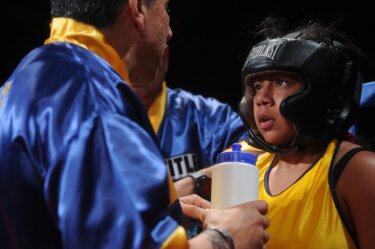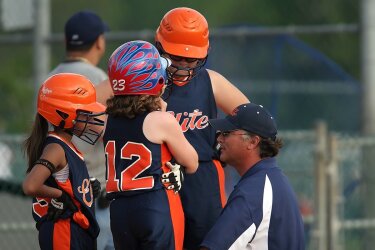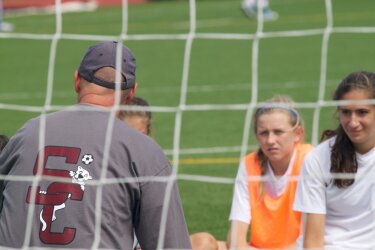(3 Minute Read)
Youth sport coaches are tasked with the difficult job of taking the abundance of knowledge they have and delivering it to athletes at various developmental stages in a way that makes sense. One way that coaches often deliver information is through offering feedback for both positive and negative behaviors. Feedback is used to increase the athlete’s performance of a movement and can come in many forms. However, not all types of feedback are created equal. While the purpose of feedback is to increase an athlete’s skill level and confidence, feedback given at the wrong time and in the wrong way can do the exact opposite. The remainder of this article will present best practices for giving feedback when teaching new skills.

To begin, it is important to understand that there are two main types of verbal feedback. The first type of verbal feedback is called supportive feedback. Supportive feedback is used to reinforce components of a skill that an athlete performed well. The second type of feedback is named change-oriented feedback. The purpose of this type of feedback is to provide an athlete with information about how to change their behavior to increase their performance. While both types of feedback are essential, they can either increase or decrease confidence and skill-based on the coach’s delivery. Feedback that is specific, directed, goal-oriented, and frequent is generally viewed as most effective.

Specific
Every skill is composed of many individual movements that work together to create the final product. Take a free-throw shot in basketball for example. Successful form has many components such as foot placement, knee bend, elbow position, eye gaze, wrist snap, and rotation of the ball. When learning a new technique, coaches often try to encourage an athlete by stating, “Good job.” However, this does not reinforce the specific movement that an athlete is working on. Instead, feedback should point to exactly what was performed right such as, “Good job snapping your wrist.”
Directed
When athletes are first learning a skill, there are many routes a coach can take to fix the incorrect movement patterns. Continuing with the previous free-throw example, some coaches may choose to start with the feet, while others may choose to begin with the form of the shot-pocket. Coaches should always be mindful of the athlete’s skill level in deciding where to begin and only ask the athlete to perform something they believe their athlete is capable of doing. Nothing reduces confidence faster than being asked to do something that is above the skill level of the athlete. Wherever a coach decides to begin, it is important to focus on teaching one component at a time. Offering feedback on multiple components of the skill at one time can overwhelm the athlete and decrease their perceived ability to make the suggested changes.
Goal-oriented
When an athlete is learning a skill, it is important for coaches to use language that promotes the idea that making the suggested corrections will get the athlete closer to their performance goals. Coaches should try and stay away from controlling language that suggests the athlete is getting closer to meeting the coach’s expectations. An example of controlling language is “That is exactly what I wanted to see.” While this feedback is encouraging, it shifts the athlete’s motivation from getting better at the skill to pleasing the coach. When an athlete’s motivation shifts to pleasing the coach, the athlete is more likely to fear failure instead of seeking success. Using language such as, “That was much better than your last shot. If you continue to snap your wrist you are going to be able to reach your goal of shooting 80% from the free-throw line.” Another example of feedback that seems to be good, but actually is controlling is, “Next time, I want you to bend your knees more.” Again, this motivates the athlete to perform to the behavior to satisfy the coach instead of improving their skill. This can easily be changed to, “Next time, you should bend your knees more to increase your power.”
Frequency
When considering how often a coach should provide feedback, coaches should consider the skill level of the athlete. Novice performers require much more feedback than experienced athletes. However, there is such a thing as too much feedback. As an athlete increases their ability to perform a skill, they also increase their ability to self-correct their mistakes based on the sensations they receive from their body. If athletes are provided with feedback after every repetition, the athlete is more likely to begin to rely on the coach’s input rather than their body and will never learn to correct their own mistakes. Generally, when compared to athletes that receive feedback after every repetition, athletes that receive feedback after a set of repetitions show larger increases in performance. As athletes become more experienced, less feedback is required.

Like many other sport skills, providing feedback does not happen in a vacuum. There are many different variables that impact the type of feedback a coach chooses to give. Therefore, having a model to help guide coaches when giving feedback can ease the decision-making process. One feedback model is called the feedback sandwich. This model sandwiches the change-oriented feedback between support and encouragement for the best results.
- Support: Verbal feedback is useless if the athlete is not listening. The first component of the feedback sandwich is offering supportive feedback to tell the athlete they did something successfully. This will catch the athlete’s attention, make them more likely to listen to the next thing the coach will say, and also reinforces a part of the skill they completed correctly. At the very least, a coach can reinforce the effort.
- Future-oriented instruction: Once a coach has an athlete’s attention, the next step is to offer change-oriented feedback for the next set of repetitions. During this component of the feedback sandwich, it is important to not dwell on what just occurred, and focus on what to do next time. If a coach spends too much time discussing what went wrong, the athlete is likely to dwell on their mistakes and decrease their confidence. During this phase, it is important to tell the athlete something that they don’t already know. To prevent this, try asking what they believe happened. This serves two purposes: 1) it will increase the athlete’s ability to detect their own mistakes and, 2) it will also provide information for the coach to better target the feedback the athlete needs. For example, if a coach notices that an athlete continues to miss a shot to the left, they can say, “I noticed your shot keeps going to the left. What do you think happened?” If the athlete needs further instruction, the coach can follow-up with, “Next time, make sure you have a wider base to center yourself.”
- Encouragement: After providing instruction, it is important for a coach to remind the athlete they have the ability to make the suggested changes. This helps build the athlete’s confidence and reinforces the idea that they should continue to strive to get better. A simple statement such as “You will get the next one” goes a long way.
Conclusion
Providing effective feedback is an art form that exists in every aspect of life. In coaching, specifically, it is important to remember to provide feedback that both increases skill level and fosters confidence. Providing effective feedback will help motivate athletes to improve, create a better coach-athlete relationship, and increase the athlete’s ability to correct their own mistakes.

Your article on providing feedback to young athletes is very useful in guiding coaches and will help them provide effective suggestions to help their young athletes.